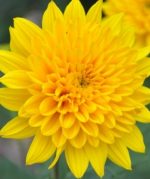
Many-flowered sunflower is a hybrid from a cross between the annual Helianthus annus and perennial Helianthus decapetalus. It is a perennial and member of the aster family, Asteraceae, that also includes daisy, yarrow and lettuce. Plants grow 3-5′ tall and have hairy, coarse leaves that are oval to heart-shaped and up to 10″ long. The 5″ wide flowerheads may be single or double and usually consist of yellow to yellow orange ray flowers surrounding a center of yellow to yellow-brown disc flowers. The flowerheads appear from late summer into fall and persist for 4-6 weeks. Plants are striking in the back of the border but have to be used with care as they tend to be coarse and brassy so can overpower more delicate plants once they bloom. Their bright color, late and long bloom, and vigorous growth, however, can be an asset especially in the fall. The genus name, Helianthus, comes from the Greek words helios, meaning sun, and anthos meaning flower and refers to the way the flowerhead responds to the sun. The specific epithet, multiflorus, comes from the Latin words multus meaning many and flos, meaning flower, and refers to the floriferous nature of the plant.
Type: Herbaceous perennial
Bloom: Flowerheads of yellow ray and disc flowers
Size:3-5′ H x 3′ W
Light:Full sun
Soil: Average, medium moist, well-drained
Hardiness: Zones 4-8
Care: Fertilize monthly; may need staking.
Pests and Diseases: Downy mildew
Propagation: Division, stem cuttings
Companion Plants: Aster, goldenrod, ornamental grass
Outstanding Selections:
‘Capenoch Star’ (single lemon-yellow flowerheads)
‘Corona Ddorica’ (5″ wide double yellow flowerheads; 5′ tall)
‘Flore-plena’ (double bright yellow flowerheads; 5′ tall)
‘Loddon Gold’ (5-6″ wide bright yellow flowerhead; 4.5-6′ tall)
‘Miss Mellish’ (semidouble flowerheads; very invasive)
‘Morning Sun’ (single yellow flowerheads with yellowish brown centers; 5′ tall)
Photo Credit: Wikipedia